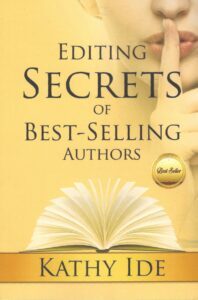Ide Teaches Self-Editing

Kathy Ide. 2020. Editing Secrets of Best-Selling Authors. Birmingham: LPCBooks.
Review by Stephen W. Hiemstra
Early in my career as an economist, I worked for the Economic Research Service in USDA, which had over two thousand economists on staff and an editorial staff to support them. First drafts went to an editor who worked to see to it that research reports were well-organized and proof-read for accuracy. If you were not used to getting substantive feedback, you had to deal with your egoism. Because publication often meant promotion, the quicker you dealt with your egoism, the better. Since then, I have always appreciated the attentiveness of my editors.
IntroductionIn her book, Editing Secrets of Best-Selling Authors, Kathy Ide writes:
“In this book you’ll find tips from actual best-selling authors who have studied editing techniques and implemented them, result in books that have reached the hearts and touched the lives of many readers.” (1)
This is a book on self-editing, which has two obvious benefits. First, it is easier to take advice from your own experience than to have it thrust on you by an editor whose objectives and standards often differ from your own. Second, an error discovered early in the editing process is cheaper and easier to correct than one discovered after your book is in print.
Trust me, I know. In my first book, I learned after passing it around that I had correctly spelled “forward,” but used it incorrectly when I meant “foreword.” I would like to believe that copies of that original printing have a market value equal to a mint-condition, 1864 Indian-head penny, but that would be self-delusional.
Background and OrganizationKathy Ide is an experienced author, editor, and events-organizer.
Kathy writes in twenty-one chapters:
Why Edit?When to EditContent EditOrganization EditCopyeditScissors EditEditing NonfictionLegal AspectsEditing MemoirEditing Fiction—IntroductionEditing Fiction—PlottingEditing Fiction—CharactersEditing Fiction—Point of ViewEditing Fiction—Scene, Sequel, and SummaryEditing Fiction—Show, Don’t TellEditing Fiction—DescriptionsEditing Fiction—DialogueFine-Tune EditProfessional EditWhen to Stop EditingTake this Job and Love It (xi-xii)These chapters are preceded by an introduction and followed by appendices with recommended resources and author biographies.
OverviewIn view of the numerous author-contributors to this book, one might conclude that this is an author-club compendium book (my own club does this almost annually), but it is not. Kathy uses her contributors to highlight and extend points that she makes in the text. As such, these author contributors add significant depth and breadth to her content.
The measure of any how-to book is whether it advances your knowledge of the subject matter. Let me highlight some of the contributions that Kathy has made here.
What is Editing?Most authors start out thinking that editing refers primarily to copyediting or, perhaps, proofreading. They scratch their heads when you mention that you employed multiple editors on a particular project, as I typically do.
For nonfiction books, I may start out with a content editor, someone able to critique my theology, and end up with proofreader/copyeditor. For fiction or memoir, I might add a developmental editor and several proofreaders/copyeditors.
Kathy’s chapter list breaks down multiple types of editing that may end up being separate editors or simply be stages that your self-editing may cover. Traditional publishers may assist with some of these steps, but increasingly these steps need to be done by the author before presenting work to an agent. Some professional editors may even insist that manuscripts reach a certain level of sophistication before they will accept them for review.
What is Good Fiction Writing?A third of Kathy’s chapters focus on editing fiction where she offers clear and helpful writing tips.
For example, what is a scene and when do you offer a scene break? She writes: “Scenes have specific locations, physical action, dialogue, and narrative.” (121) “A chapter or scene break can indicate a change in point-of-view character, location, and/or time.” (113) More generally, a scene must add new information, advance the plot, or offer aspects of setting that affect the characters or plot. If not, the scene should either be cut or summarized (123). Action scenes are often followed by sequels, where characters respond to actions from a previous action scene (122).
Citing Lena Nelson Dooley, Kathy writes in discussing point of view (POV) that an author can pull a person into a character’s deep spaces by visiting secret desires, wounds, or plans (114). Delving into the concept of “deep POV,” Kathy writes:
“Wherever you’ve written that a character thought, believed, wondered, noticed, saw, felt, knew, or decided something, take those words out and simply show what was thought, observed, or felt. A Character doesn’t think those words, so they shouldn’t appear in the narrative.” (115)
While this is a comment about editing, it provides tangible advice on implementing deep POV. This may sound obvious, but POV questions can seem slippery to an author starting out—like so many other things, it is easy the second time.
AssessmentKathy Ide’s Editing Secrets of Best-Selling Authors is a helpful and an accessible guide to self-editing a manuscript with specific guidance for editing nonfiction, memoir, and fiction. Aspiring writers and experienced authors will both find editing gems in this book.
FootnotesCapital Christian Writers Fellowship (https://ccwritersfellowship.org).
Ide Teaches Self-EditingAlso see:Books, Films, and MinistryOther ways to engage online:Author site: http://www.StephenWHiemstra.netPublisher site: http://www.T2Pneuma.com Newsletter at: https://bit.ly/trans_22, Signup
The post Ide Teaches Self-Editing appeared first on T2Pneuma.net.



